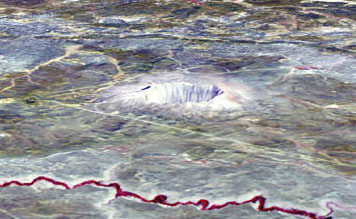Not all asteroids are in a circular orbits about the
Sun or at the Lagrange points. There are some
asteroids that are in elliptical orbits that can
bring these asteroids close to
Earth. These
asteroids are called Near Earth Objects, or NEO's. More information can be found on the Near Earth Object Fact Sheet.
NEO's have struck
Earth in the past. Examples are:
- The Tunguska Event in 1908
- The Barringer Meteorite Crater - impact
about 50,000 years ago
- Extinction of the dinosaurs - 10 km
meteorite impact about 65 million years ago
This image of the Barriner Meteorite Crater gives
a bit of a sobering warning of the potential hazards
of NEO's:

This crater is 167 meters deep and 1.22
kilometers in diameter! This impact was no where
near the significance of the impact that caused the
extinction of the dinosaurs. The extinction of the
dinosaurs is believed to have occurred at the K-T
boundary (K = Cretaceous Period, T = Tertiary
Period). This boundary corresponds to 65 million
years ago. The impact crater is believed to be in
Mexico's Yucatan Peninsula (lower Gulf of Mexico)
called Chicxulub. This impact crater is believed to
be about 10 km in diameter with the energy of the
impact roughly equal to 100,000,000 megatons of TNT
(6 million times the energy of the Mount St, Helen's
eruption in 1980). Here is a diagram of the
Chicxulub crater:

Notice that the crater is now underwater.
Smaller meteors have also impacted
Earth, even in
the present time. Meteors that survive passage
through the atmosphere and impact are called
meteorites while the space debris that burns up
in the atmosphere are called meteors. In
space, these objects are called asteroids. There are
three major types of meteorites:
-
Stony meteorites - combination
of equal parts of rock and iron
-
Iron meteorites - contain little
of no stone and about 10 to 20% nickel
-
Carbonaceous chondrites -
containing carbon compounds and may also contain
water bound up in minerals (as a result of
heating)
While these smaller meteorites are
of little concern, there are programs designed to
keep a close watch on the NEO's.
Amateurs can also participate in NEO
studies. While the equipment amateurs have access to
will be unable to discover new objects, the tracking
of existing objects is possible. The Committee on
Science, U.S. House of Representatives hearing on
The Threat of Near-Earth Asteroids
acknowledges the amateurs contribution to this
search.
Amateurs can do real science! While
my area of interest is exoplanet detection, I have
also entertained the idea of owning a dedicated
telescope to assist in the tracking of NEO's.
Back to Top |

